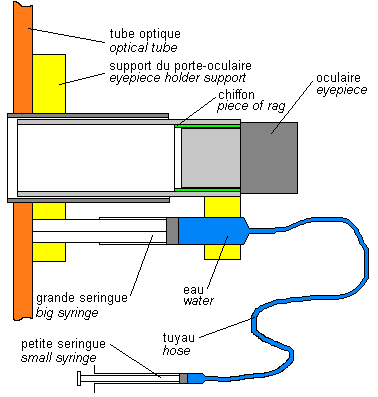
Astronomy
Equatorial Table
Hydraulic Focussing
Stepper Motor
How To Make A Telescope
Information for Beginners
Links And Bibliography
Gastronomy
Recipe Schematics
Recipes
To Bake A Well-Risen Cake
Links
Photography
Astronomy
Architecture
Animals
Landscape
Crafts
Livroscope
Read Html Books On Screen
High Rise Handlebars Bike
Dominoes
Power Electronics
Heatsink Impedance
Chess

http://queribus.free.fr
1. Mechanical Issue
Small telescopes are poorly designed. Most of the time they are equiped with a rack-and-pinion focussing device whose gear have play. It is absolutely unacceptable for a good focussing. Unfortunatelly this remark often apply to bigger scopes.
1.2 Light Telescopes
Small telescopes are too light. When you touch the focussing knob, the image vibrates, which makes observing unpleasant and focussing difficult. A capstan focussing system solves the problem of the play but the telescope still vibrates when the capstan is touched.
2. A Hydraulic Focussing System
Hydraulic focussing solves both problems because it is precise and does not transmit vibration from the observer to the image. Unlike traditional rack-and-pinion or capstan systems, hydraulic focussing is adapted for astronomical observation
The principle is the one of the hydraulic press. You control the movement of the eyepiece with the small syringe. If liquid is injected in the big syringe, the eyepiece moves back, if liquid is sucked out, the eyepiece moves forward. Given the difference in diameter of the two syringes, the movement of the eyepiece is 7 to 10 times smaller than the movement of the piston of the small syringe pushed or pulled by the observer.
It is reasonably possible to move the small piston with a precision of 0.1 mm, which gives a precision of 10 to 20 microns on the movement of the eyepiece. In a rack-and-pinion system, play is 10 to 20 times bigger. Therefore hydraulic focussing is a significant improvement.
2.2 Reliability
Water is an incompressible liquid, the observer's movement is totally transmitted to the eyepiece, without any noticeable play and with a constant friction. But the eyepiece cannot transmit any movement to the small syringe, therefore eye pressure on the eyepiece does not change focussing because the necessary pressure that would be necessary to push the liquid into the small syringe is too high.
Moreover, the observer can handle the small syringe without transmitting any vibration to the image.
Hydraulic focussing is therefore reliable because it is not impaired by shocks and vibration.
All materials can be found second hand, except for syringes which must be new and clean. It is not only an obvious health issue: a dirty syringe helps bubbles building up and makes bleeding difficult.
Hydraulic focussing is a lot cheaper than rack-and-pinion or capstan.
3. Using the Hydraulic Focussing System
The liquid must be totally bled. The slightest air bubble cancels the interest of the system. It is not difficult because the smallest bubbles are visible and bleeding only requires a minute. Bleeding once before every night is necessary because bubbles may reappear after 24 hours.
2. A Hydraulic Focussing System
3. Using the Hydraulic Focussing System
4. Applications

PVC pipes hold the eyepiece. They slide one into the other with an important play but do not affect very much the quality of the image.
The piece of rag adjusts the diameter of the pipe to the diameter of the eyepiece.

